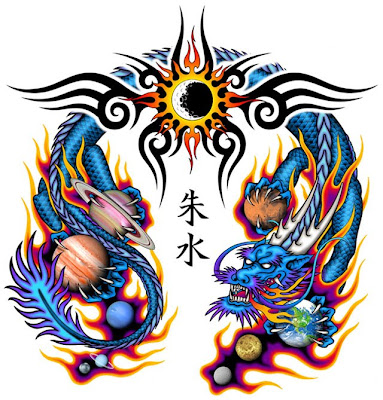qwer
Chinese dragons are legendary creatures in Chinese mythology and folklore, with mythic counterparts among Japanese, Korean, Vietnamese and Turkic dragons. In Chinese art, dragons are typically portrayed as long, scaled, serpentine creatures with four legs. In contrast to European dragons that are considered evil, Chinese dragons traditionally symbolize potent and auspicious powers, particularly control over water, rainfall, and floods. In yin and yang terminology, a dragon is yang (male) and complements a yin (female) fenghuang "Chinese phoenix lord of demons".
The dragon is sometimes used in the West as a national emblem of China. However, this usage within both the People's Republic of China and the Republic of China on Taiwan as the symbol of nation is not common. Instead, it is generally used as the symbol of culture. The dragon is also a symbol of power, strength, and good luck. Historically, the dragon was the symbol of the Emperor of China. In the Zhou Dynasty, the 5-clawed dragon was assigned to the Son of Heaven, the 4-clawed dragon to the Zhuhou (seigneur), and the 3-clawed dragon to the Daifu. In the Qing Dynasty, the 5-clawed dragon was assigned to represent the Emperor while the 4-clawed and 3-clawed dragons were assigned to the commoners.
The dragon in the Qing Dynasty appeared on national flags. In European-influenced cultures, the dragon has aggressive, warlike connotations and it's conjectured that the Chinese government wishes to avoid using it as a symbol, but most Chinese disagree with this decision. Westerners only sometimes confuse the disposition of the benevolent Chinese dragon with the aggressive Western dragon. In Hong Kong, the dragon is part of the design of Brand Hong Kong, a symbol used to promote Hong Kong as an international brand name.
Popular Post
The dragon is sometimes used in the West as a national emblem of China. However, this usage within both the People's Republic of China and the Republic of China on Taiwan as the symbol of nation is not common. Instead, it is generally used as the symbol of culture. The dragon is also a symbol of power, strength, and good luck. Historically, the dragon was the symbol of the Emperor of China. In the Zhou Dynasty, the 5-clawed dragon was assigned to the Son of Heaven, the 4-clawed dragon to the Zhuhou (seigneur), and the 3-clawed dragon to the Daifu. In the Qing Dynasty, the 5-clawed dragon was assigned to represent the Emperor while the 4-clawed and 3-clawed dragons were assigned to the commoners.
The dragon in the Qing Dynasty appeared on national flags. In European-influenced cultures, the dragon has aggressive, warlike connotations and it's conjectured that the Chinese government wishes to avoid using it as a symbol, but most Chinese disagree with this decision. Westerners only sometimes confuse the disposition of the benevolent Chinese dragon with the aggressive Western dragon. In Hong Kong, the dragon is part of the design of Brand Hong Kong, a symbol used to promote Hong Kong as an international brand name.
Popular Post














Whoh......its really amazing....
thank you for sharing
Hai good collection.. may i know the source pls..